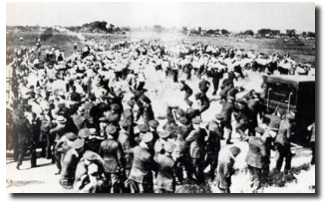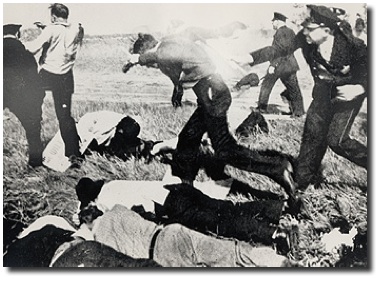The 1937 Memorial Day Massacre
"We Don't Want Fascism in America"
The policeman wearing Badge #7181 pulled Earl Handley out of a car marked with a Red Cross sign, a makeshift ambulance. The 37-year-old carpenter for Inland Steel was bleeding profusely, but the cop dragged him along like a drunk. Handley died because his wounds were not treated.
Meyer Levin saw the police prevent Burnside Hospital ambulances from taking the wounded to the hospital. Patrolman Walter B. Oakes attacked Joseph Rothmund and then killed him, shooting Rothmund in the back as he fled.
May 2012 marks the 75th anniversary of “the Memorial Day Massacre.” Ten people were killed and 90 wounded that day when the police attacked a peaceful march outside the Republic Steel plant in South Chicago. All the dead were shot in the back or the side.
The march came just days after the beginning of a strike called by the Steel Workers Organizing Committee (SWOC) against Republic Steel and two other companies. During the 1930s, Republic Steel was known as one of the worst places to work in the steel industry. Republic Steel paid low wages, drove its workers hard, and provided no medical care or pension plan. Republic Steel fought unionization even after the largest employer in the steel industry – the U.S. Steel Corporation, known as “Big Steel” – agreed to unionization in early 1937. 
The Republic Steel Corporation spent tens of thousands of dollars to stockpile machine guns, rifles, revolvers, tear gas, and bombs in the weeks before the strike began. It also established a private police force of close to 400 men.
The strike involving 85,000 steelworkers began at the 11 p.m. shift change on May 26, 1937. Confrontations between workers and the police began even before the official start of the strike, as police prevented mass picketing in front of the main entrance of Republic’s South Chicago plant. The union called for a mass meeting at Sam’s Place, an abandoned tavern serving as union headquarters, for Sunday, May 30 -- Memorial Day.
Memorial Day 1937 was a hot, sunny day with temperatures reaching 88 degrees. By about 3 p.m., some 1500 strikers and their supporters had gathered at Sam’s Place. About 15 percent of the crowd was made up of women and children. After two CIO leaders spoke, union organizer Joe Weber read several resolutions to be sent to government officials protesting police misconduct at Republic Steel. The resolutions were approved by acclamation. A member of the crowd then made a motion that a march be undertaken to the plant gate to establish mass picketing. The motion carried.
About 1,000 people formed up behind two American flags and began to march south toward the main entrance to the plant, chanting, “CIO, CIO!”
As the marchers approached the plant, they found about 400 cops waiting for them, in double file, with their billy clubs drawn.
The marchers urged the police to let them through to set up their picket line. A stand-off ensued for several minutes. Some marchers were beginning to move back toward Sam’s Place when a stick rose from the rear of the marchers’ line and flew toward the police. Almost simultaneously, tear gas bombs were thrown by police at the marchers. Then the police drew their revolvers and fired point blank into the retreating marchers. Within 15 seconds, about 200 shots were fired.
 The police literally threw the wounded into patrol wagons, stacking them like firewood on top of each other. None of the wounded received first aid before being tossed inside. Patrol wagons designed to hold eight prisoners were filled with twice that many. The most seriously wounded were taken to a hospital at least 30 miles away. The police literally threw the wounded into patrol wagons, stacking them like firewood on top of each other. None of the wounded received first aid before being tossed inside. Patrol wagons designed to hold eight prisoners were filled with twice that many. The most seriously wounded were taken to a hospital at least 30 miles away.
The Chicago police department, the Republic Steel Corporation, and anti-union publications like the Chicago Tribune tried to justify the killing, claiming that the strikers were armed and attempting to seize the plant. A Paramount News camera was mounted on a truck directly behind the police. The Paramount film clearly shows the peaceful nature of the march and the police responsibility for the violence.
Within weeks of the tragedy, a U.S. Senate committee issued a scathing report which placed responsibility for the violence squarely on the shoulders of the Chicago police.
While the strikers were forced to return to work in mid-June 1937, they ultimately succeeded in their campaign to unionize Republic Steel. The company was eventually forced to sign a union contract just months after the United States entered World War II.
The anniversary of the Memorial Day Massacre should remind us how much sacrifice was required to win labor rights in this country. Those of us in UNITE HERE can be proud that one of UNITE HERE’s predecessors – the Amalgamated Clothing Workers of America – contributed many organizers to the long, bitter campaign to organize the steel industry. One of them, an ACWA founder and vice-president, spoke at the rally which preceded the march to Republic Steel. In a prophetic speech given about an hour before the massacre, ACWA leader Leo Krzycki told the strikers, “Violence against peaceful picketing must stop. Republic Steel must abide by the Wagner Act. We don’t want fascism in America.”
Fascism is a system of government in which workers are denied any rights whatsoever. That’s what Nazi Germany and Mussolini’s Italy had become before World War II. Back then, there were forces who wanted to turn America into a fascist police state too. These forces wanted to crush the union organizing drives which swept across this country during the 1930s.
Today, labor is again faced with the challenge of standing up to a systematic attempt to deny us our most basic human rights. After years of plant closings and anti-union legislation and court rulings, the percentage of American workers organized into unions is actually lower now than it was during the 1930s. It’s a very sad state of affairs when a smaller portion of the work force is in unions than it was when workers in a big city could get shot in the back for demonstrating near a plant gate!
The seriousness of the current situation should remind us that Leo Krzycki’s message still rings true: We don’t want fascism in America!
The articles on this page are written by Chris Mahin for the Education and Mobilization Department of the Chicago & Midwest Regional Joint Board of UNITE HERE and originally appeared on the Joint Board’s website.
Special thanks to Brother Mahin for allowing the Pennsylvania Federation access to his writings.
|
